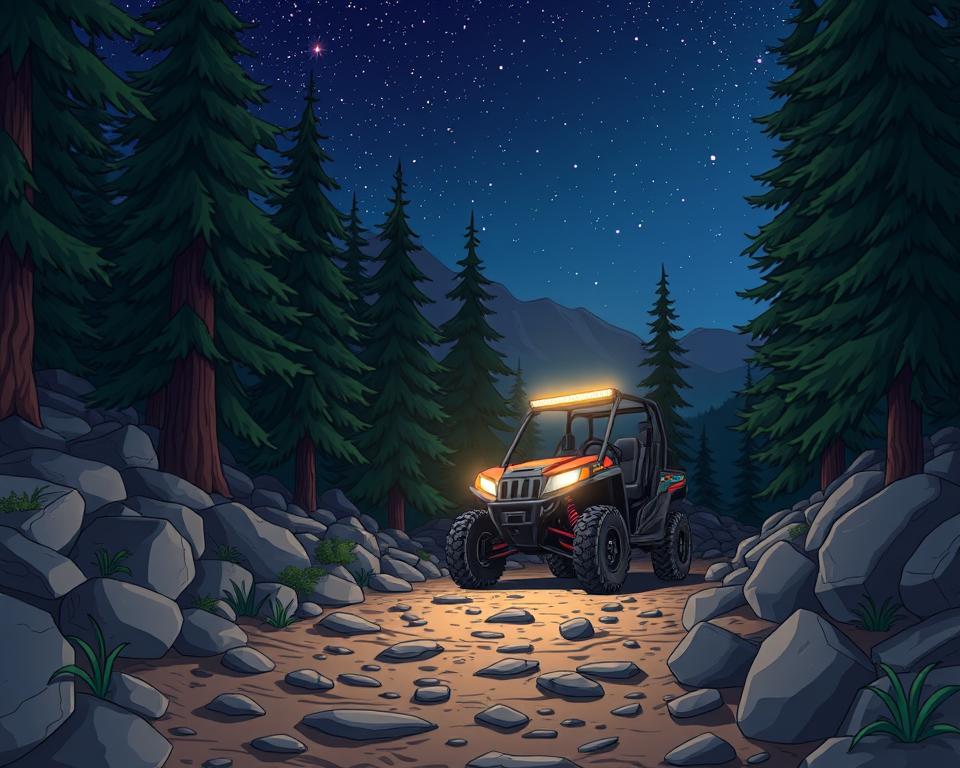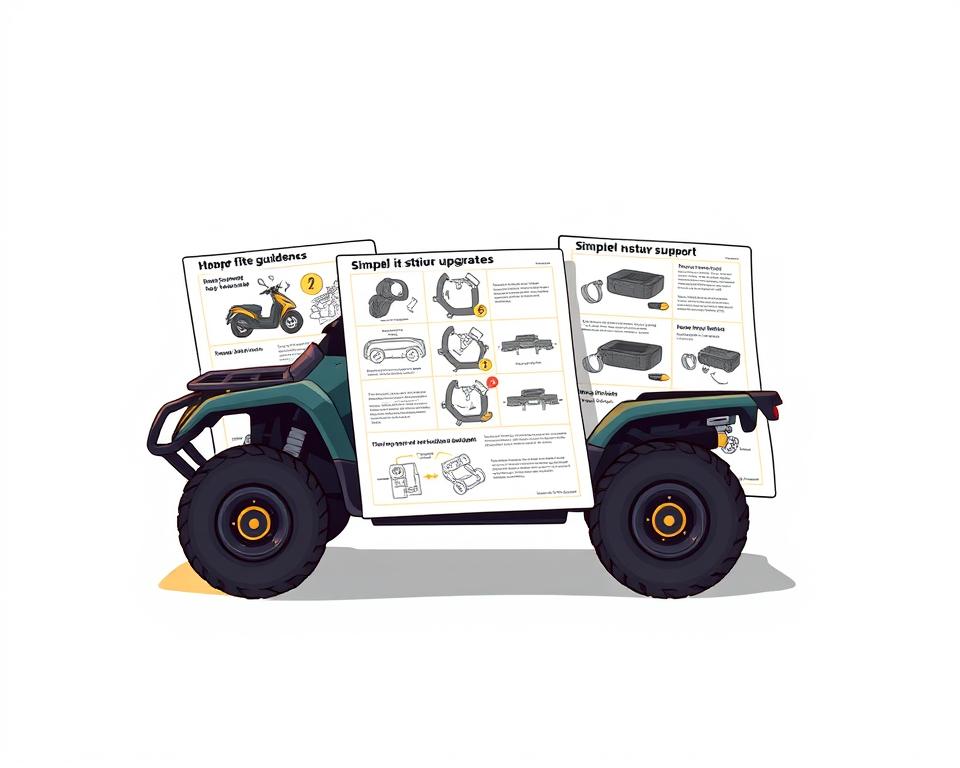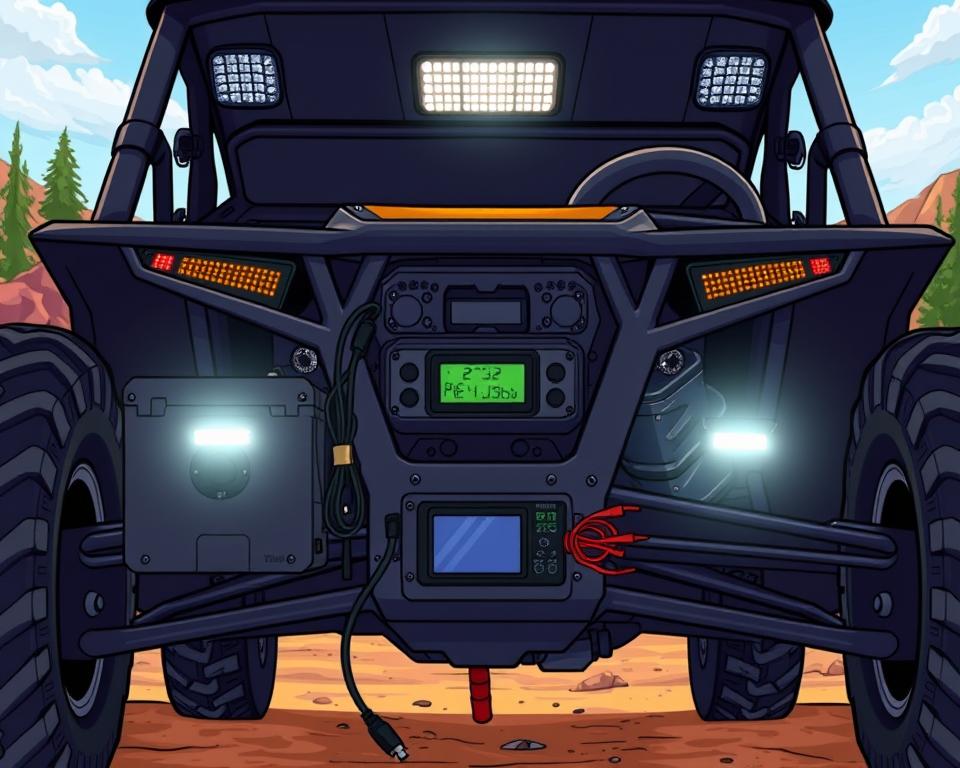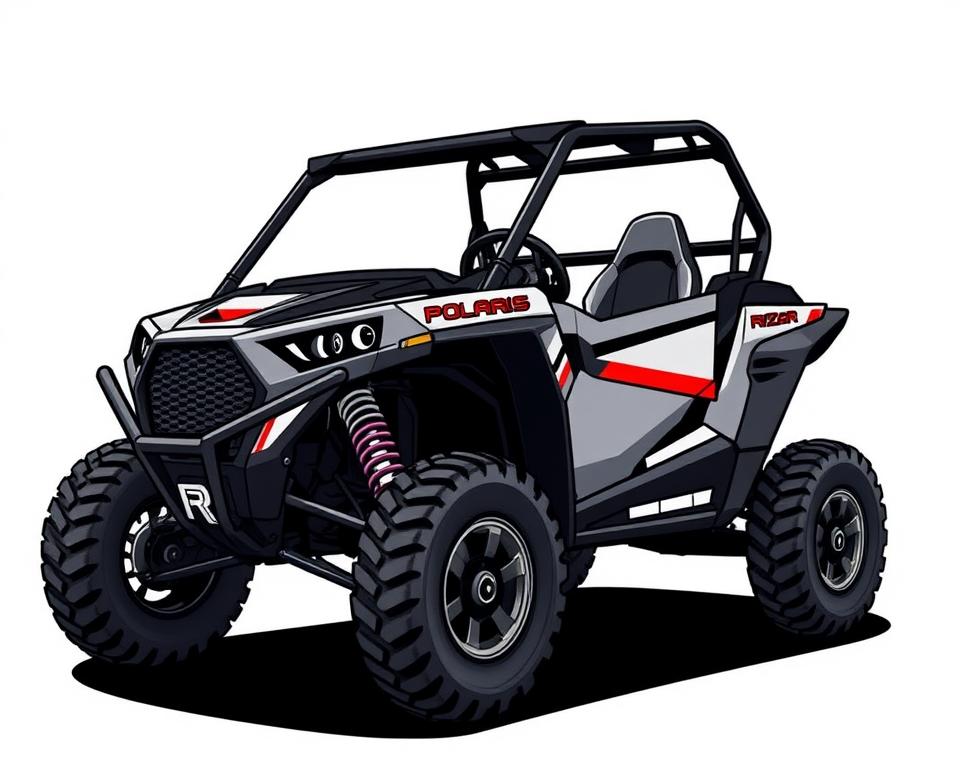Must-Have ATV Off-Road Safety Checklist
It’s interesting to note nearly about 450,000 ATV-related injuries are treated in U.S. emergency rooms each year? Such a high number stresses the importance of being prepared and safe on the trails. The Essential ATV Off-Road Checklist is your guide to a safe and enjoyable ride. It covers everything from rocky trails to sand dunes. With the right safety gear and Can Am defender max limited lifted essentials, you can minimize risks and boost your adventure.
Critical Findings
- Prioritize safety by using the Essential ATV Off-Road Checklist for optimal preparation.
- An ATV safety gear checklist is vital for protecting yourself during off-road rides.
- Regular maintenance is key to keep your ATV in top shape.
- Hydration and nutrition boost endurance and focus on long rides.
- Learn to use navigation tools to avoid getting lost on off-road routes.
- Pack layers and waterproofs for all conditions.
- Trailside fixes? Have your toolkit and recovery gear ready.
Understanding the Importance of Safety Gear
Safety is non-negotiable for every off-road trip. The excitement of ATVs brings potential hazards. Protective equipment shields you from crashes and bumps. Gear up correctly with this ATV safety gear checklist.

Essential Protective Gear
Maximizing protection involves several key items:
- Helmets: Always use a DOT helmet to guard against head trauma.
- Eye Protection: Use goggles to shield your eyes from dust and debris.
- Gloves: Grip and guard your hands with sturdy gloves.
- Footwear: Ankle-support boots are a must.
- Body Armor: Chest and back armor add vital protection.
- Neck Braces: A neck brace protects your spine in a crash.
Emergency Preparedness
Don’t overlook your emergency kit. A well-packed kit might save your life. Key items to include are:
- First aid kit
- Multi-tool
- Tire repair kits
- Portable air compressors
- Emergency blankets
- Whistles
- Matches
ATV Equipment for Optimal Performance
The right kit makes all the difference. Knowing the must-have ATV equipment ensures you’re ready for any journey. Routine checks keep your ATV working its best.
Must-Have ATV Equipment
- Durable Tires: Terrain-specific tires keep you glued to the track.
- Cargo Systems: Use efficient storage compartments for tools and emergency supplies, ensuring quick access when needed.
- Quality Fuel Tank: Opt for a robust tank to avoid drips and dry runs.
- First Aid Kit: Stock your kit with bandages, antiseptic, and meds.
Regular Maintenance for Longevity
A maintenance schedule is your ATV’s best friend. Regular inspections should encompass:
- Checking air filters to keep the engine running smoothly.
- Lubricating the chain to ensure optimal performance.
- Test your brakes on every pre-ride check.
This ATV maintenance checklist is essential for keeping your vehicle in peak condition and ready for adventure.
The Essential ATV Off-Road Checklist
Don’t skip your pre-ride safety scan. Use this pre-ride checklist to avert trouble before it starts. Every point matters—don’t rush. A little prep goes a long way.
Pre-Ride Inspection Basics
Before any off-road journey, a pre-ride inspection is vital. Find and fix small problems before they grow. Key elements to check include:
- Tire pressure and tread condition
- Fluid levels such as oil and fuel
- Brakes and controls functionality
- Operational lights and horn
- Chain or driveshaft integrity
T-CLOC Inspection Method
Use T-CLOC for a thorough pre-ride check. Five key areas: T-CLOC ensures all are inspected. This method ensures all critical areas are covered:
| Inspection Area | Checklist Items |
|---|---|
| Tires and Wheels | Check tire pressure, inspect tread depth, look for damage |
| Controls | Test brakes, throttle, and clutch for smooth operation |
| Lights | Ensure headlights, brake lights, and indicators are functioning |
| Oil and Fuel | Check oil level, inspect for leaks, and fill fuel tank |
| Chain/Driveshaft | Examine for wear, proper tension, and lubrication |
Spending a few minutes on this ATV maintenance checklist can make rides safer and more enjoyable. Prevent roadside repairs with a fast check.
Hydration and Nutrition for Long Rides
Long ATV rides require careful attention to hydration and nutrition. Always carry more water than you think you’ll need. Water packs help maintain endurance and alertness. Nutritious snacks power you through rough stretches.
Importance of Staying Hydrated
Hydration is critical for ATV riders to stay alert and capable throughout their journey. Sipping regularly prevents performance drops. Backpack reservoirs keep water flowing hands-free.
High-Energy Snacks to Pack
Choosing the right snacks is vital for extended ATV rides. Opt for non-perishable items that are easy to consume. Some ideal choices include:
- Protein bars
- Nut mixes
- Dried fruits
- Beef jerky
Snack smart for sustained energy. Mix sweet and salty options for flavor and function.
Navigation Tools for Off-Roading Adventures
Stay on course with proven navigation aids. Off-road navigation tools are invaluable for staying on track, no matter the terrain.
Advanced GPS Systems
High-end GPS units guide you through the wild. GPS should work without cell service and last all day. Brands like Garmin and TomTom offer models designed for off-road use, ensuring durability and precision.
Traditional Navigation Aids
Don’t ditch old-school compasses and maps. A compass never needs a signal. Wind your own way with map and compass skills. Tech plus tools equals total navigation readiness.
Communication Equipment for Safety
Stay in touch even off the grid. Using reliable ATV communication gear is vital for safety. Knowing you can call for help reduces stress.
Don’t split up without radios in hand. Opt for radios rated for miles of reach. Stay informed of detours or emergencies instantly. When choosing two-way radios, look for models with:
- Weatherproof construction to resist the elements
- Long battery life for extended trips without needing a recharge
- Multiple channels for clear communication without interference
Always include comms in your gear list. They keep everyone coordinated and secure. Radios cut through noise and barriers. Clear comms = better rides.
Self-Rescue Gear for ATV Riders
Self-rescue gear is as vital as your helmet. Self-rescue gear for ATVs is key to handling challenges on your own. A well-prepared rider not only improves their experience but also boosts safety for all.
Winches and Recovery Kits
Winches are vital for self-rescue, helping pull your ATV from tough spots. Kit up your winch for maximum extraction muscle. Recovery kits usually include:
- Tow straps
- D-rings
- Recovery boards
- Gloves
Understanding how to use this gear boosts ATV riders’ confidence in navigating rough terrain. With quality ATV recovery kits, you can overcome mud, rocks, or other obstacles and continue your journey.
Trail Recovery Essentials
Winches are just the start; several trail recovery essentials are also critical for off-road adventures. These include:
| Equipment | Purpose |
|---|---|
| Recovery Straps | Used for towing or pulling ATVs out of tight situations. |
| Shovel | Helps clear obstacles and dig out vehicles when stuck. |
| Traction Mats | Provides grip under tires in muddy or slick conditions. |
| Portable Air Compressor | Enables quick tire inflation after deflating for better traction. |
Arming your ATV with the right self-rescue gear ensures you can handle any obstacles. Practice rescues so you’re ready when it counts.
Staying Adaptable: Preparing for Weather Changes
Trail weather can change in minutes. It’s vital to be ready for sudden changes to stay safe and enjoy the ride. Don’t forget your layers and rain shell.
Layering your clothes is key to adapting to temperature changes. Start with wick-away fabrics. Mid-layers trap heat and pack small. Your shell fights off wind and rain. Stay dry and warm through all conditions.
Weather-Appropriate Clothing
- Rain Shells: A must-have for sudden downpours.
- Ventilated Off-Road Pants: Allows for ventilation while protecting against wet conditions.
- UV Gear: Sun-blocking shirts and hats prevent overexposure.
- Cold-Weather Gloves: Insulate your hands against cold snaps.
Don’t let the weather ruin your ride. It keeps you comfortable and safe, letting you enjoy the adventure without worrying about the weather.
Tools for On-Trail Repairs
Essential repair tools are a rider’s best friend. Don’t skimp on repair gear. Tackle trailside trouble with confidence.
Must-Have Tools and Kits
A well-prepared rider should assemble a basic tool kit. Pack only the essentials—no junk. Critical ATV repair tools might include:
- Tire irons for changing flat tires
- Pliers for gripping and cutting
- Wrenches for various sizes of bolts and nuts
- A multi-tool for versatility
- Spare items such as spark plugs and electrical wire
- Duct tape for quick fixes
Tools at hand mean no surprises.
Basic Emergency Supplies
In addition to essential tools, packing basic emergency supplies for ATV is vital. These supplies help ensure your safety in challenging situations:
- First aid kit for injuries
- Flashlight with extra batteries for night-time visibility
- Emergency whistle for signaling assistance
- Reflective triangles or flares to warn other riders
- Water and high-energy snacks for sustenance
Preparedness significantly impacts your off-roading experience. Your safety net on the trail.
Final Thoughts
Success and enjoyment in off-road adventures depend on thorough preparation. Check off each item and pick reputable brands. Be set for rocks, sand, mud—anything.
Load up on safety, navigation, and comms gear. Plan smart to ride hard and safe. Embrace excitement, ditch the doubts.
Gear up, stay sharp, and savor every off-road second. Your ride’s story begins with good prep. Check this list, then conquer nature.
FAQ
What should I include in my ATV safety gear checklist?
Start with a DOT helmet and sturdy goggles. Add gloves, boots, and torso protection. Consider a neck brace for extra safety. Also bring a medical kit and adaptable multi-tool.
How do I keep my ATV in top shape?
Inspect air filters and grease the chain often. Always test your brakes before a ride. A consistent maintenance routine extends your machine’s life and keeps it ready for off-road adventures.
What is included in T-CLOC?
T-CLOC inspects five critical systems. Cover Tires, Controls, Lights, Oil/Fuel, Chain in T-CLOC. Using T-CLOC guarantees safe, smooth rides.
Recommended hydration levels for trail rides?
Overestimate your water needs. Accurately estimating hydration needs prevents fatigue, which is critical during long rides. Hydration packs make accessing water easy.
What should I bring for navigation during my off-road adventure?
For navigation, invest in an advanced GPS system designed for off-road use. Combine this with traditional aids like waterproof maps and compasses.
Why carry two-way radios?
Radios prevent isolation when cell fails. Radios work where phones don’t.
Essential recovery gear for off-road?
Be ready with winch and recovery essentials. Have straps, shackles, mats, and gloves on hand.
Tips for weather readiness off-road?
To prepare for sudden weather changes, wear layered clothing that can be adjusted as temperatures change. Waterproof gear is necessary to stay dry during unexpected rain. Wear sun-blocking fabrics and hats.
Which trailside tools matter most?
Carry essential wrenches, pliers, and irons. Don’t forget duct tape and electrical wire.


